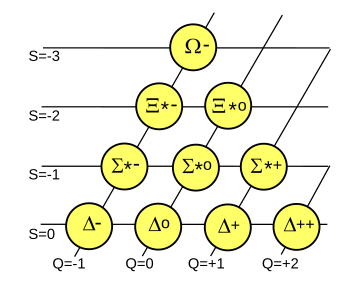Memristors
August 21, 2023
Mothers shouldn't have
favorites, but
Mother Nature is partial to
designs that exhibit
simplicity and
symmetry. Common
non-biological examples would be the the symmetry of
crystals and
snowflakes, a consequence of the
angles of
atomic bonds. Symmetry also abounds in the biological world, as the mostly
mirror symmetry of the
human body demonstrates. Biological symmetry occurs more often than expected, and a recent
study published in the
Proceedings of the National Academy of Sciences suggests that this is a consequence of
genetic efficiency.[1-2]
Researchers ran an
evolutionary computer simulation on a
protein cluster with 13,079,255 possible
structure shapes for which just five shapes had the symmetry of a
square. There would be a five in thirteen million
chance of
evolutionary forces selecting a square, but the
evolutionary algorithm returned a square 30% of the time.[1-2] The
conjecture is that it's easier to have a
process repeat a simple instruction multiple times than having a detailed and more
complex process. The basis of this conjecture is
algorithmic information theory.[1-2]
Physics has multiple examples of symmetry, most being too difficult to easily explain, that have lead to important discoveries, such as the
Omega-minus (Ω-) particle. The Ω
- was discovered at
Brookhaven National Laboratory in 1964. This discovery confirmed the 1961
theory of the
quark model by
American physicist Murray Gell-Mann (1929-2019) and
Israeli physicist
Yuval Ne'eman (1925-2006). The quark theory proposed the
classification of
hadrons through a symmetry named
SU(3). Gell-Mann was awarded the 1969
Nobel Prize in Physics for his work.

A baryon decuplet of Delta (Δ), Sigma (Σ), Xi (Ξ), and Omega (Ω) baryons.
This is a nice graphical example of symmetry in physics.
In this illustration, Q is electric charge and S is strangeness.
(Created using Inkscape, and also at Wikimedia Commons. Click for larger image.)
Leon Chua,
famous for his
eponymous chaotic oscillator circuit,[3] discovered a symmetry in
passive electrical devices that led to discovery of a new
circuit element, the
memristor.[4] This device
complements the trio of traditional passive devices, the
resistor, the
capacitor and the
inductor. The memristor is simply a device with resistance that depends on
current flow. Its resistance increases when current flows through it in one direction, and decreases when current flows through it in the other direction. A memristor exhibits
non-volatility in that it remembers its most recent resistance when current is removed.

The four passive electrical circuit elements are defined by the following equations:
Resistor: dv = R⋅di
Capacitor: dq = C⋅dv
Inductor: dφ = L⋅di
Memristor: dφ = M⋅dq
in which
v is the
voltage,
i is the
current,
φ is the
magnetic flux, and
q is the electric charge.
R,
C,
L and
M are the
resistance,
capacitance,
inductance and
memristance, respectively.
(Created using
Inkscape, and also at
Wikimedia Commons.
Click for larger image.)
The first actual device to be named a memristor was described in a 2008 paper in
Nature.[5] However, this
Hewlett Packard device acts by
ionic migration in a 5
nanometer film of
titanium dioxide and not the faster, and more useful,
electromagnetic effect involving
magnetic flux.[5] Although Chua changed his view of memristors to conform to such devices, there was immediate
controversy about whether the memristor had actually been discovered.[6] I personally believe that a true memristor is yet to be discovered.
In a
chapter in a 2013
book,
Jean-Marc Ginoux and Bruno Rossetto of the
Universitè du Sud (La Garde Cedex, France) discuss a
19th century device that they suggest was the first memristor.[7] While this device, the
singing arc of
William Du Bois Duddell (1872-1917),[8] has some properties analogous to those of a memristor, their argument is not quite convincing to me.

The singing arc of William Du Bois Duddell (1872-1917).
In graduate school, I suppressed the electromagnetic interference of arcing relay contacts in a high temperature furnace controller by using a similar circuit.
(Created using Inkscape. Click for larger image.)
The
invention of the
singing arc was devised as a solution to the practical problem that
carbon arc lamps used for
lighting before the introduction of practical
incandescent light bulbs emitted an
annoying hissing
sound.[7] In 1899, Duddell, a physicist, was
commissioned by the
British government to find a way to stop this
noise.[7] He found that the addition a capacitor and inductor as a
tuned circuit produced a musical tone.[7] As Duddell wrote,
"A direct-current arc of suitable length and current between solid carbons, will give out a musical note if it be shunted with a condenser in series with a self-induction..."[8]
It was found subsequently by
Danish engineer,
Valdemar Poulsen (1869-1942) that selected values of these produced radio waves, and this arc circuit was used in wireless communication for several decades.[7]
Ginoux and Rossetto write that the
voltage-current characteristic curve of the
singing arc can be expressed by the same
hyperbolic function as a memristor, and both devices exhibit a
closed loop hysteresis.[7] For those reasons, they conclude that the singing arc could be considered to be the oldest memristor.[7]
References:
- Iain G. Johnston, Kamaludin Dingle, Sam F. Greenbury, Chico Q. Camargo, Jonathan P. K. Doye, Sebastian E. Ahnert, Ard A. Louis, "Symmetry and simplicity spontaneously emerge from the algorithmic nature of evolution," Proceedings of the National Academy of Science, vol. 119, no. 11 (March 11, 2022), Article no. e2113883119, https://doi.org/10.1073/pnas.2113883119.
- Nature prefers symmetry and simplicity, Oxford University Press Release, 31 March 31, 2022.
- T. Matsumoto, "A chaotic attractor from Chua's circuit," IEEE Transactions on Circuits and Systems, vol. 31, no. 12, (December, 1984), pp. 1055-1058, DOI: 10.1109/TCS.1984.1085459.
- Leon O. Chua, "Memristor - The Missing Circuit Element," IEEE Transactions on Circuit Theory, vol. 18, no. 5 (September 1971), pp. 507-519.
- Dmitri B. Strukov, Gregory S. Snider, Duncan R. Stewart, and R. Stanley Williams, "The missing memristor found," Nature, vol. 453 (May 1, 2008), pp. 80-83, https://doi.org/10.1038/nature06932.
- Sascha Vongehr, "Missing the Memristor," Advanced Science Letters, vol. 17, no. 1 (October 1, 2012), pp. 285-290, https://doi.org/10.1166/asl.2012.4241. Also at Sascha Vongehr, "The Missing Memristor: Novel Nanotechnology or rather new Case Study for the Philosophy and Sociology of Science?" arXiv, March 1, 2012, https://doi.org/10.48550/arXiv.1205.6129.
- Jean-Marc Ginoux and Bruno Rossetto, "The Singing Arc: The Oldest Memristor?" in Chaos, CNN, Memristors and Beyond, pp. 494-507 (World Scientific Publishing, 2013), https://doi.org/10.1142/9789814434805_0040. Also at Jean-Marc Ginoux and Bruno Rossetto, "The singing arc: the oldest memristor?," arXiv, August 21, 2014, https://doi.org/10.48550/arXiv.1408.5103.
-
W. Du Bois Duddell, "On Rapid Variations in the Current through the Direct-Current Arc," Journal Inst. Elec. Eng., vol. 30 (December 13, 1900), pp.232-283.
Linked Keywords: Mother; favorite; Mother Nature; design; simplicity; symmetry; biology; non-biological; crystal; snowflake; angle; chemical bond; atomic bond; reflection symmetry; mirror symmetry; human body; scientific method; study; scientific literature; publish; PNAS; Proceedings of the National Academy of Sciences; genetics; genetic; efficiency; research; researcher; evolutionary computation; evolutionary computer simulation; protein complex; protein cluster; molecular structure; geometry; shape; square (geometry); probability; chance; evolutionary biology; evolutionary forces; evolutionary algorithm; conjecture; process; complexity; complex; algorithmic information theory; physics; Omega baryon; Omega-minus (Ω-); elementary particle; Brookhaven National Laboratory; Eightfold Way (physics); theory; quark model; America; American; physicist; Murray Gell-Mann (1929-2019); Israel; Israeli; Yuval Ne'eman (1925-2006); categorization; classification; hadron; special unitary group SU(3); Nobel Prize in Physics; baryon decuplet; Delta baryon; Sigma baryon; Xi baryon; baryon; electric charge; strangeness; Inkscape; Wikimedia Commons; Leon O. Chua; famous; Chua's circuit; eponymous; chaotic oscillator circuit; electrical network; passive electrical device; circuit element; memristor; complementary; complement; resistor; capacitor; inductor; electric current; current flow; non-volatile memory; non-volatility; passive electrical circuit elements; equation; voltage; current; magnetic flux; resistance; capacitance; inductance; Inkscape; Nature (journal); Hewlett Packard; ion; ionic; electromigration; nanometer; coating; film; titanium dioxide; electromagnetism; electromagnetic; magnetic flux; controversy; chapter (books); book; Jean-Marc Ginoux; Universitè du Sud (La Garde Cedex, France); 19th century; singing arc; William Du Bois Duddell (1872-1917); graduate school; electromagnetic interference; electric arc; arcing; relay; electrical connector; contact; muffle furnace; high temperature furnace; process control; controller; circuit; invention; carbon; arc lamp; electric lighting; incandescent light bulb; acoustic emission; emit; annoyance; annoying; sound; contract; commission; Government of the United Kingdom; British government; noise; tuned circuit; Denmark; Danish; engineer; Valdemar Poulsen (1869-1942); voltage-current characteristic curve; hyperbolic function; closed loop hysteresis.